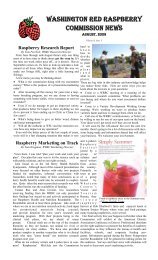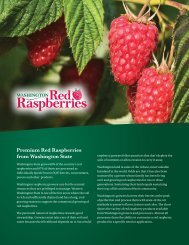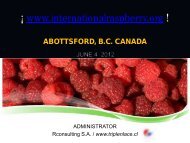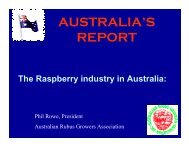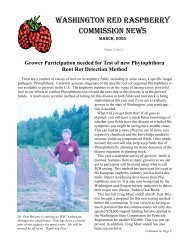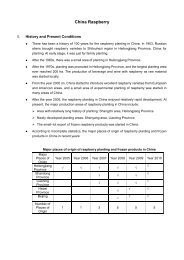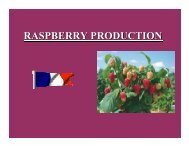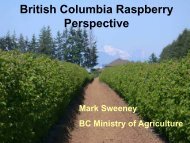2012 - Washington Red Raspberry Commission
2012 - Washington Red Raspberry Commission
2012 - Washington Red Raspberry Commission
You also want an ePaper? Increase the reach of your titles
YUMPU automatically turns print PDFs into web optimized ePapers that Google loves.
Project Title: Fungicide Resistance in Botrytis in <strong>Washington</strong> Berries<br />
2) Details of Project:<br />
Crop/Site: <strong>Raspberry</strong>/Blueberry Chemical: Several<br />
Pest Management Issue: Resistance to fungicides<br />
Pest: Botrytis cinerea<br />
5) Project Category: Check all that describe the focus of your project.<br />
Registration ____%<br />
___Efficacy Trial<br />
___ Phytotoxicity Study<br />
___ Residue Study<br />
Non Registration: 100 %<br />
4) Research Lead:<br />
Alan Schreiber,<br />
ADG, Inc.<br />
aschreib@centurytel.net<br />
____ Integrated Pest Management<br />
X Resistance Management<br />
___ Other:<br />
6) Project Duration Start Date : February 1, 2013 End Date October, 30, 2013<br />
7) Total Project Cost $ 11,300 WRRC Request $ 3,000<br />
Co-funding $ 8,300<br />
___ GLP<br />
X non-GLP<br />
Project Summary: <strong>Raspberry</strong> and blueberry suffer heavily from Botrytis, which has a history of<br />
developing resistance to fungicides. Growers treat each crop three to six times per season with a<br />
limited number of products. The number of products available is further limited by MRL and label<br />
restrictions. The same set of products is used for its control on both crops. 2011 failures in the field<br />
raised the specter of resistance. An internal research project of an agrichemical company conducted<br />
in <strong>2012</strong> indicated that multiple fungicides may have resistance issues on raspberries. We propose to<br />
sample raspberry and blueberry fields throughout western <strong>Washington</strong> to survey for resistance to a<br />
range of fungicides. This information is expected to result in a revision in disease control programs<br />
for <strong>Washington</strong> berries and may result in pursuit of emergency exemptions for both crops.<br />
Description of Problem. Botrytis cinerea, a fungus that causes blossom blight, preharvest rot,<br />
postharvest rot, and cane infections. On raspberry, it overwinters as sclerotia on canes and<br />
mycelia in dead leaves and mummified fruit. Sclerotia produce conidia in spring. A moist, humid<br />
environment is ideal for pathogen sporulation and spread. All flower parts except sepals are<br />
very susceptible. Initial infections of flowers are latent such that the fungus is dormant until fruit<br />
ripens. Fruit rot may be more prevalent in wet weather, in fields under overhead set irrigation<br />
systems, or where fruit ripens in the field for mechanical harvest. Conidia can infect mature or<br />
senescent leaves, resulting in primocane infections through petioles.<br />
On blueberry, it survives as sclerotia (resistant survival structure) and dormant mycelium on<br />
dead twigs of bushes and prunings. It also overwinters as a saprophyte on dead organic matter<br />
and dead plant parts in or on the soil surface. In spring, these tissues produce vast numbers of<br />
spores during wet periods. Spores spread primarily by wind but also by splashing water.<br />
Cultivars that tend to retain floral structures over a long period are more susceptible. Also,<br />
branch tips killed by low winter temperatures are easily infected. Green fruit can rot when rains<br />
continue into the late spring and early summer. Infection is more likely on fruit that retains old<br />
floral tissue.<br />
This is the most treated for disease of berries in <strong>Washington</strong> with growers applying three to six<br />
applications per season starting with a prebloom application and continuing through to harvest.<br />
(Growers who are applying only three or four applications are probably incurring significant<br />
economic losses from the disease.) There is no threshold for this disease. If you find it, think<br />
you have it or are at risk of having it, you have to start a treatment program. The PNW Small<br />
Fruit Research Center ranks it as a number one priority for research for blueberry and<br />
092



